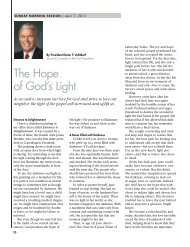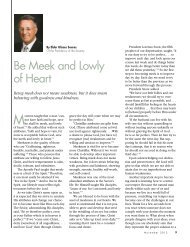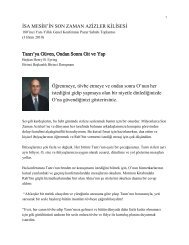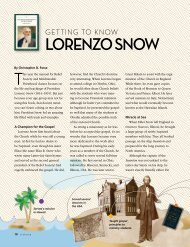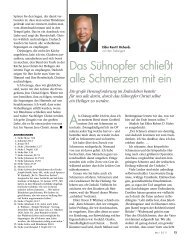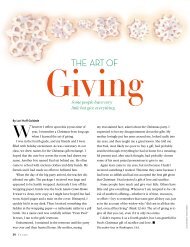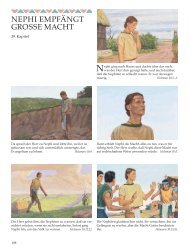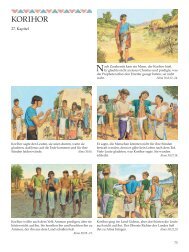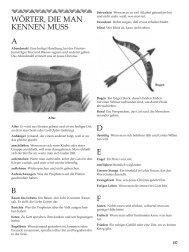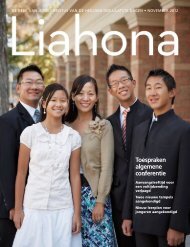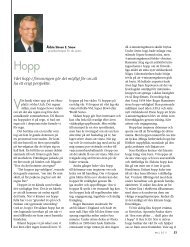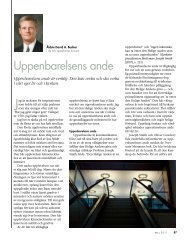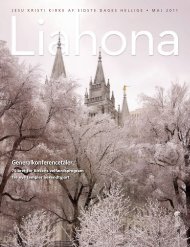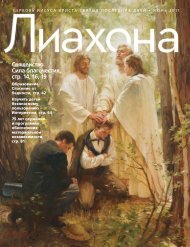April 2005 Ensign - The Church of Jesus Christ of Latter-day Saints
April 2005 Ensign - The Church of Jesus Christ of Latter-day Saints
April 2005 Ensign - The Church of Jesus Christ of Latter-day Saints
You also want an ePaper? Increase the reach of your titles
YUMPU automatically turns print PDFs into web optimized ePapers that Google loves.
36<br />
Business Ventures in Kirtland<br />
In 1821 or 1822 Newel Whitney set up his first Kirtland<br />
store in a log cabin on the property <strong>of</strong> Ann’s uncle Elijah<br />
Smith. <strong>The</strong> operation continued to grow. Ann recalled <strong>of</strong><br />
these earlier years: “He accumulated property faster than<br />
most <strong>of</strong> his companions and associates. Indeed, he<br />
became proverbial as being lucky in all his undertakings.” 3<br />
Newel’s keen business mind saw the potential <strong>of</strong> an intersection<br />
in the north part <strong>of</strong> the township with some <strong>of</strong> the<br />
heaviest traffic in all <strong>of</strong> northeastern Ohio. He purchased<br />
Peter French’s apple orchard on the northwest corner <strong>of</strong> the<br />
intersection on June 1, 1822, where he built what his family<br />
called their “Red Store.” This small 20-by-40-foot store<br />
sharply contrasted with Sidney Gilbert’s large<br />
operation. <strong>The</strong> two men would consistently<br />
differ in their business approach through the<br />
years: N. K. Whitney built small, while his<br />
friend Sidney Gilbert built large.<br />
<strong>The</strong> following year Newel bought more<br />
land from Peter French a few hundred yards<br />
southeast <strong>of</strong> his first piece <strong>of</strong> property, and<br />
there he built an ashery. Frontier settlers<br />
brought wood to the Whitney ashery for<br />
money or credit. He used the wood to heat<br />
huge cauldrons <strong>of</strong> water that had been alkalinized<br />
by running it through wood ashes<br />
gathered from farmers’ fields and his own<br />
operations. <strong>The</strong> remains after the water<br />
boiled away made potash or the more refined pearl ash,<br />
used in making glass, in cleaning wool, and in other industrial<br />
processes. Newel Whitney shipped most <strong>of</strong> these chemicals<br />
in large barrels to factories in the East or Great Britain.<br />
Within two months <strong>of</strong> buying the ashery lot, Newel K.<br />
Whitney married Elizabeth Ann Smith. Just west <strong>of</strong> and<br />
behind the Red Store the Whitneys built a modest home<br />
with a summer kitchen attached on the back. <strong>The</strong>y painted<br />
their small frame house and placed a well-made fence<br />
around each <strong>of</strong> their properties.<br />
In the fall <strong>of</strong> 1825 N. K. traveled to New York on a buying<br />
trip in time to bring his goods back on the <strong>day</strong> the last<br />
segment <strong>of</strong> the new Erie Canal opened. <strong>The</strong> opening <strong>of</strong><br />
the canal marked the start <strong>of</strong> a major expansion <strong>of</strong> Newel<br />
Whitney’s economic activities in Kirtland. He bought a<br />
quarter-acre lot across the road from his home and built<br />
a store a little more than 1,500 square feet that the family<br />
called the “White Store.” When Newel invited Sidney<br />
Gilbert to help him capitalize on this new opportunity,<br />
N. K. Whitney and Company was born.<br />
Religious Involvement<br />
While they busied themselves establishing a family and<br />
business, Newel K. and Ann Whitney were drawn to a<br />
<strong>Christ</strong>ian reformation movement in the region. Sidney<br />
Rigdon, a Reformed Baptist minister in neighboring Mentor,<br />
began baptizing a number <strong>of</strong> Kirtland residents into a movement<br />
that sought to restore primitive <strong>Christ</strong>ianity. Followers<br />
<strong>of</strong> this movement became popularly known as Campbellites.<br />
N. K. and Ann Whitney were drawn to the movement<br />
because its “principles seemed most in<br />
accordance with the Scriptures.” 4<br />
On September 22, 1829, exactly two<br />
years after Joseph Smith received the gold<br />
plates, the Painesville Telegraph, read in<br />
Kirtland, published an article under the<br />
heading “Golden Bible,” announcing that<br />
someone in New York claimed to have seen<br />
the “spirit <strong>of</strong> the Almighty.” 5 During this<br />
same period Ann and N. K. had a singular<br />
experience while searching out the things<br />
<strong>of</strong> the Spirit with Sidney Rigdon’s group.<br />
Ann recalled: “It was midnight—as my<br />
husband and I, in our house at Kirtland,<br />
were praying to the Father to be shown the<br />
way, the Spirit rested upon us and a cloud overshadowed<br />
the house. . . . <strong>The</strong> house passed away from our vision.<br />
We were not conscious <strong>of</strong> anything but the presence <strong>of</strong> the<br />
Spirit and the cloud that was over us. . . . A solemn awe<br />
pervaded us. We saw the cloud and felt the Spirit <strong>of</strong> the<br />
Lord. <strong>The</strong>n we heard a voice out <strong>of</strong> the cloud, saying,<br />
‘Prepare to receive the word <strong>of</strong> the Lord, for it is coming.’<br />
At this we marveled greatly, but from that moment we<br />
knew that the word <strong>of</strong> the Lord was coming to Kirtland.” 6<br />
In late October 1830 Kirtland’s citizens were again confronted<br />
with news <strong>of</strong> the “golden bible” when four <strong>Latter</strong><strong>day</strong><br />
Saint missionaries stopped in neighboring Mentor to<br />
visit Sidney Rigdon, who had been the spiritual leader <strong>of</strong><br />
one <strong>of</strong> the missionaries, Parley P. Pratt. After reading the<br />
Book <strong>of</strong> Mormon, Sidney Rigdon took the missionaries to<br />
his various congregations, which was probably how they<br />
were first introduced in Kirtland. <strong>The</strong>ir teaching had a<br />
COURTESY OF LDS CHURCH ARCHIVES



